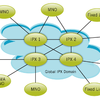
On July 11th, Dialogic held a webinar with Light Reading called “The Rise of NFV and the Software Telco.” If you missed the live webcast, you can still download it on-demand, or read this whitepaper from Heavy Reading. I actually like it so much I read it 17 times so far! We had a great response to the webinar. Here are the top three questions from webinar attendees.
Q: How will virtualizing an SBC provide SIP trunking migration?
A: An SBC is an IP-to-IP device with SIP trunks on one side in an enterprise environment. A software-based SBC would still act as an SBC, and one side of the SBC would be the SIP trunk coming in, just like the hardware-based SBC. In a hardware based on, the SIP trunk from the “internet cloud” could be physically connected to the device. In a software/virtualized SBC, the physical connection from the “internet cloud” could occur in some other location and the trunk data could be carried to the SBC before it enters the enterprise realm. In that way, the “border control” still occurs - just in a different location. Migration of the SIP trunks though, could be easier since there is no physical connection. The IP address would just have to change.
Q: Codecs were based on and tested on specific hardware; as we move to software codecs, will the testing process be the same, or will there be more hypervisor consideration? In the past when we’ve developed codecs with specific hardware in mind; in the future, how will testing change?
A: This was an interesting question. At Dialogic, we have hardware and software versions of an SBC. The testing is the same with regards to codecs. There is no reason it shouldn’t be, considering the use cases of the products are the same. So the testing has to be the same. If the question is about cordoning off a piece of code since a hypervisor is involved, well, the testing of that code has to be the same.
Q: Who is behind NFV? Are there savings for carriers from implementation? Who is driving NFV among carriers and vendors?
A: NFV is being driven by ETSI, but the telecom operators are committed and part of the process as there are 50+ operators involved. Dialogic is part of the standardization group, as well. The operators are committed because there are savings in the following areas for them:
- CAPEX. Software-based products in COTS platforms in data centers (that the carriers themselves have been investing in).
- OPEX. The above, into COTS platforms, drives down OPEX expenditures.
- Services Agility. Because of the software-based infrastructure models, rolling out services can be faster and cheaper.












